Mybatis多对一、一对多处理
前提环境搭建
1.在数据库中创建表
CREATE TABLE `teacher` ( `id` INT(10) NOT NULL, `name` VARCHAR(30) DEFAULT NULL, PRIMARY KEY (`id`) ) ENGINE=INNODB DEFAULT CHARSET=utf8 INSERT INTO teacher(`id`, `name`) VALUES (1, '秦老师');

CREATE TABLE `student` ( `id` INT(10) NOT NULL, `name` VARCHAR(30) DEFAULT NULL, `tid` INT(10) DEFAULT NULL, PRIMARY KEY (`id`), KEY `fktid` (`tid`), CONSTRAINT `fktid` FOREIGN KEY (`tid`) REFERENCES `teacher` (`id`) ) ENGINE=INNODB DEFAULT CHARSET=utf8 INSERT INTO `student` (`id`, `name`, `tid`) VALUES ('1', '小明', '1'); INSERT INTO `student` (`id`, `name`, `tid`) VALUES ('2', '小红', '1'); INSERT INTO `student` (`id`, `name`, `tid`) VALUES ('3', '小张', '1'); INSERT INTO `student` (`id`, `name`, `tid`) VALUES ('4', '小李', '1'); INSERT INTO `student` (`id`, `name`, `tid`) VALUES ('5', '小王', '1');
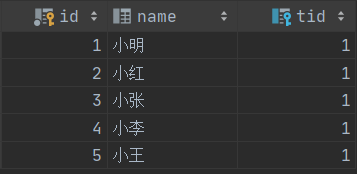
此时我们的数据就是多个学生对应一个老师,一个老师对应多个学生
然后我们需要先创建一个Maven项目,可参考我之前编写的Maven项目的创建
2.导入相关依赖包
<!-- Mybatis核心 --> <dependency> <groupId>org.mybatis</groupId> <artifactId>mybatis</artifactId> <version>3.5.7</version> </dependency> <!-- junit测试 --> <dependency> <groupId>junit</groupId> <artifactId>junit</artifactId> <version>4.12</version> <scope>test</scope> </dependency> <!-- MySQL驱动 --> <dependency> <groupId>mysql</groupId> <artifactId>mysql-connector-java</artifactId> <version>5.1.3</version> </dependency> <!-- lombok插件 --> <dependency> <groupId>org.projectlombok</groupId> <artifactId>lombok</artifactId> <version>1.18.10</version> </dependency>
3.创建MyBatis的核心配置文件
先配置一个数据库配置文件db.properties,配置文件存放的位置是src/main/resources目录下
driver=com.mysql.jdbc.Driver
url=jdbc:mysql://192.168.111.131:3306/mybatis?characterEncoding=UTF-8
username=root
password=123456
然后创建MyBatis核心配置文件,习惯上命名为mybatis-config.xml,核心配置文件存放的位置是src/main/resources目录下
<?xml version="1.0" encoding="UTF-8" ?> <!DOCTYPE configuration PUBLIC "-//mybatis.org//DTD Config 3.0//EN" "http://mybatis.org/dtd/mybatis-3-config.dtd"> <configuration> <!--引入外部配置文件--> <properties resource="db.properties"/> <settings> <!--实体类驼峰命名与数据库_命名映射开启--> <setting name="mapUnderscoreToCamelCase" value="true"/> </settings> <!--设置连接数据库的环境--> <environments default="development"> <environment id="development"> <transactionManager type="JDBC"/> <dataSource type="POOLED"> <property name="driver" value="${driver}"/> <property name="url" value="${url}"/> <property name="username" value="${username}"/> <property name="password" value="${password}"/> </dataSource> </environment> </environments> <!--引入映射文件--> <mappers> <mapper resource="mappers/StudentMapper.xml"/> <mapper resource="mappers/TeacherMapper.xml"/> </mappers> </configuration>
4.编写Mybatis工具类
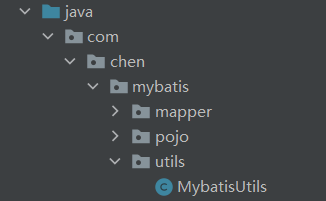
public class MybatisUtils {
private static SqlSessionFactory sqlSessionFactory;
static {
try {
//读取MyBatis的核心配置文件
InputStream is = Resources.getResourceAsStream("mybatis-config.xml");
//创建SqlSessionFactoryBuilder对象
SqlSessionFactoryBuilder sqlSessionFactoryBuilder = new SqlSessionFactoryBuilder();
//通过核心配置文件所对应的字节输入流创建工厂类SqlSessionFactory,生产SqlSession对象
sqlSessionFactory = sqlSessionFactoryBuilder.build(is);
} catch (IOException e) {
e.printStackTrace();
}
}
public static SqlSession getSqlSession(){
//参数true为设置自动提交
return sqlSessionFactory.openSession(true);
}
}
多对一
查询多个学生信息及对应老师信息
1.创建实体类
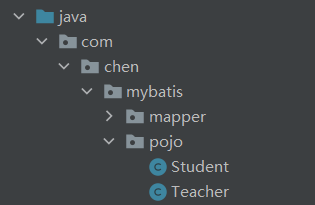
该地方我们使用的是Lombok配置实体类,可以通过Lombok的配置使用对其进行了解
@Data public class Student { private int id; private String name; private Teacher teacher; }
@Data public class Teacher { private int id; private String name; }
2.创建Mapper接口
MyBatis中的mapper接口相当于以前的dao。但是区别在于,mapper仅仅是接口,我们不需要提供实现类。
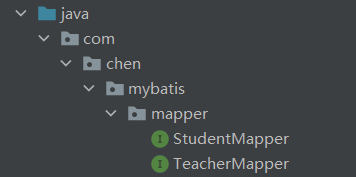
public interface StudentMapper { //查询所有学生信息和对应老师信息 public List<Student> getStudent(); }
public interface TeacherMapper { //Teacher在此不需要定义方法 }
3.创建MyBatis的映射文件
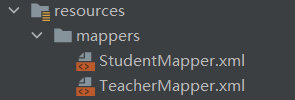
注:mapper接口的全类名和映射文件中的命名空间(namespace)保持一致。
方式一:按照查询嵌套处理(子查询)
该方式比较麻烦的就是需要写两个sql语句,将表A查询sql的结果赋给表B的查询sql,理解下来就是类似于子查询
StudentMapper.xml
<?xml version="1.0" encoding="UTF-8" ?> <!DOCTYPE mapper PUBLIC "-//mybatis.org//DTD Mapper 3.0//EN" "http://mybatis.org/dtd/mybatis-3-mapper.dtd"> <mapper namespace="com.chen.mybatis.mapper.StudentMapper"> <!--这里resultMap自定义名称,和下方的resultMap对应即可--> <select id="getStudent" resultMap="StudentTeacher"> select * from student </select> <resultMap id="StudentTeacher" type="com.chen.mybatis.pojo.Student"> <result property="id" column="id" /> <result property="name" column="name" /> <!--复杂属性处理,对象用association,集合用collection--> <!--这里column填的是student的外键,也是teacher的主键,javaType绑定我们另一个对象teacher类型,select绑定另一个语句,也就是我们下方的语句--> <association property="teacher" column="tid" javaType="com.chen.mybatis.pojo.Teacher" select="teacherInfo" /> </resultMap> <!--不难看出,我们这里的tid也就是上方所传递过来的--> <select id="teacherInfo" resultType="com.chen.mybatis.pojo.Teacher"> select * from teacher where id = #{tid} </select> </mapper>
方式二:按照结果嵌套处理(联表查询)简单点
该方式虽然不用写多个sql语句,但是需要给查出来的字段都设置别名,个人感觉的话,可能方式二更容易写一点,当然,不用写多个sql的话其实就是联表查询了
StudentMapper.xml
<?xml version="1.0" encoding="UTF-8" ?> <!DOCTYPE mapper PUBLIC "-//mybatis.org//DTD Mapper 3.0//EN" "http://mybatis.org/dtd/mybatis-3-mapper.dtd"> <mapper namespace="com.chen.mybatis.mapper.StudentMapper"> <!--该方式需要给查询出来的字段都取别名--> <select id="getStudent" resultMap="StudentTeacher"> select s.id sid,s.name sname,t.name tname from student s,teacher t where s.tid = t.id </select> <!--然后再将查出来的字段与我们的别名进行映射--> <resultMap id="StudentTeacher" type="com.chen.mybatis.pojo.Student"> <result property="id" column="sid" /> <result property="name" column="sname" /> <!--这里直接指定另一个表的类型,然后再进行别名映射--> <association property="teacher" javaType="com.chen.mybatis.pojo.Teacher"> <result property="name" column="tname" /> </association> </resultMap> </mapper>
4.测试
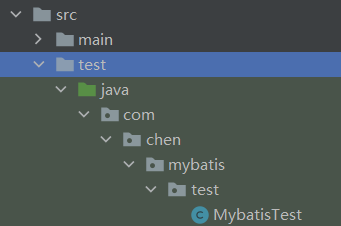
public class MybatisTest { @Test public void testMybatis() { SqlSession sqlSession = MybatisUtils.getSqlSession(); StudentMapper studentMapper= sqlSession.getMapper(StudentMapper.class); List<Student> studentList = studentMapper.getStudent(); for(Student student:studentList){ System.out.println(student); } sqlSession.close(); } }
一对多
查询一个老师及对应的多个学生信息
1.创建实体类

该地方我们使用的是Lombok配置实体类,可以通过Lombok的配置使用对其进行了解
@Data public class Student { private int id; private String name; private int tid; }
@Data public class Teacher { private int id; private String name; private List<Student> students; }
2.创建Mapper接口
MyBatis中的mapper接口相当于以前的dao。但是区别在于,mapper仅仅是接口,我们不需要提供实现类。

public interface StudentMapper { //Student在此不需要定义方法 }
public interface TeacherMapper { //获取指定老师的信息及对应的多个学生的信息 Teacher getTeacher(int id); }
3.创建MyBatis的映射文件

注:mapper接口的全类名和映射文件中的命名空间(namespace)保持一致。
方式一:按照查询嵌套处理(子查询)
该方式比较麻烦的就是需要写两个sql语句,将表A查询sql的结果赋给表B的查询sql,理解下来就是类似于子查询
TeacherMapper.xml
<?xml version="1.0" encoding="UTF-8" ?> <!DOCTYPE mapper PUBLIC "-//mybatis.org//DTD Mapper 3.0//EN" "http://mybatis.org/dtd/mybatis-3-mapper.dtd"> <mapper namespace="com.chen.mybatis.mapper.TeacherMapper"> <select id="getTeacher" parameterType="int" resultMap="TeacherStudent"> select * from teacher where id = #{id} </select> <resultMap id="TeacherStudent" type="com.chen.mybatis.pojo.Teacher"> <!--这里因为映射的是集合所有用collection,ofType代表集合里的类型--> <collection property="students" column="id" ofType="com.chen.mybatis.pojo.Student" select="StudentInfo"/> </resultMap> <select id="StudentInfo" resultType="com.chen.mybatis.pojo.Student"> select * from student where tid = #{id} </select> </mapper>
方式二:按照结果嵌套处理(联表查询)简单点
该方式虽然不用写多个sql语句,但是需要给查出来的字段都设置别名,个人感觉的话,可能方式二更容易写一点,当然,不用写多个sql的话其实就是联表查询了
TeacherMapper.xml
<?xml version="1.0" encoding="UTF-8" ?> <!DOCTYPE mapper PUBLIC "-//mybatis.org//DTD Mapper 3.0//EN" "http://mybatis.org/dtd/mybatis-3-mapper.dtd"> <mapper namespace="com.chen.mybatis.mapper.TeacherMapper"> <select id="getTeacher" parameterType="int" resultMap="TeacherStudent"> select t.id teid,t.name tename,s.id sid,s.name sname from teacher t,student s where t.id=s.tid and t.id = #{id}; </select> <resultMap id="TeacherStudent" type="com.chen.mybatis.pojo.Teacher"> <result property="id" column="teid" /> <result property="name" column="tename" /> <!--复杂属性处理,对象用association,集合用collection 注意这里使用的是ofType不是javaType --> <collection property="students" ofType="com.chen.mybatis.pojo.Student"> <result property="id" column="sid" /> <result property="name" column="sname" /> </collection> </resultMap> </mapper>
4.测试

public class MybatisTest {
@Test public void testMybatis() { SqlSession sqlSession = MybatisUtils.getSqlSession(); TeacherMapper teacherMapper = sqlSession.getMapper(TeacherMapper.class); Teacher teacher = teacherMapper.getTeacher(1); System.out.println(teacher); sqlSession.close(); }
}
小结
关联 - association 多对一
集合 - collection 一对多
javaType 用来指定我们实体类中属性的类型
ofType 用来指定集合中的类型
该文档来自狂神说Java
b站视频链接https://www.bilibili.com/video/BV1NE411Q7Nx?p=22&spm_id_from=pageDriver





【推荐】国内首个AI IDE,深度理解中文开发场景,立即下载体验Trae
【推荐】编程新体验,更懂你的AI,立即体验豆包MarsCode编程助手
【推荐】抖音旗下AI助手豆包,你的智能百科全书,全免费不限次数
【推荐】轻量又高性能的 SSH 工具 IShell:AI 加持,快人一步
· 25岁的心里话
· 闲置电脑爆改个人服务器(超详细) #公网映射 #Vmware虚拟网络编辑器
· 基于 Docker 搭建 FRP 内网穿透开源项目(很简单哒)
· 零经验选手,Compose 一天开发一款小游戏!
· 一起来玩mcp_server_sqlite,让AI帮你做增删改查!!